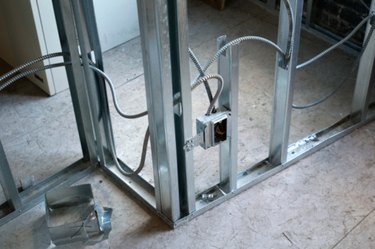
Although they aren't the best option for every situation, metal framing studs do offer advantages over wood ones. They are always straight, and the method of installation guarantees a straight and plumb wall with minimum measurement. Moreover, they are light, which means less structural load and heavy lifting.
Most metal studs are fabricated from galvanized steel, and that gives them another advantage over wood: They can't rot. Moreover, they eliminate the need to drill holes for wires and pipes because the holes are already precut. They do necessitate the use of special self-tapping screws when installing drywall, but the screws are readily available and not much more expensive than conventional drywall screws. Metal studs vary in shape, width, thickness, and depth, and it's important to understand the variations so you can use the right ones for your job.
Video of the Day
Video of the Day
Here's a brief discussion of types of metal framing studs.
Standard C-Shaped Studs
Rather than being fully enclosed, metal studs are open on one side, and the most common cross-section is shaped like a flattened letter "C." The top and bottom of the letter, which are the parts of the stud that face the walls, are called the flanges, while the part that forms the back of the "C" is the web. The flanges usually bend inward on the outside edges to form a lip, also known as a return. The width of the flange and lip along with the thickness of the metal determine the strength of the stud.
Webbing width determines the wall thickness and varies from 1 5/8 inches all the way to 16 inches. Flange width varies from 1 1/4 to 3 1/2 inches and not only determines the stud's load capacity (the wider the flange, the stronger the stud) but also how much area is available for attaching drywall. Lip width also determines stud strength and can be either 1/2, 5/8, or 3/4 inch. Finally, the thickness of the metal itself, known as the gauge, can vary from 1.994 mils (14 gauge) to 0.551 mils (26 gauge).
Tracks, Furring Strips, and L-Headers
When framing a wall with wood studs, you use the same 2x4 material for the top and bottom plates as you do for the studs but not when framing with metal studs. Instead, you need a track, which looks a lot like the C-shaped studs except for the lack of a lip. Some manufacturers identify tracks as U-channel and some don't, but for all intents and purposes, they are the same. The width of U-channel webbing runs in the same range as the stud webbing, and the flange width, commonly 1/2 inch, determines the depth of the channel.
Two other steel framing members you might have occasion to use are furring channels and L-headers. Furring channels have a "C" shape, but instead of lips, they have wide flanges that extend outward for attachment to a solid surface. A common use for these is installation of suspended ceilings. L-headers, shaped, of course, like the letter "L," are for use as headers in load-bearing walls.
Identifying Steel Framing Members
When selecting studs and U-channel, you'll see a series such as this: 350 - S -162 - 43. The first number refers to the web depth and the second to the type of framing member: stud (S), track (T), furring channel (F), and L-header (L). The third number refers to flange width and the fourth to metal thickness. Web depth and flange width are expressed in hundredths of an inch, while metal thickness is expressed in mils (thousandths of an inch). The identification system makes it easy to choose framing members that all have the same width and thickness.